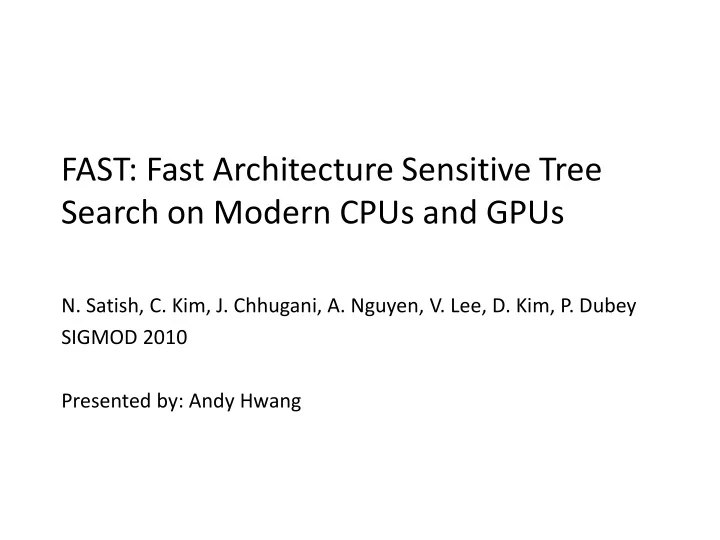

FAST: Fast Architecture Sensitive Tree Search on Modern CPUs and GPUs N. Satish, C. Kim, J. Chhugani, A. Nguyen, V. Lee, D. Kim, P. Dubey SIGMOD 2010 Presented by: Andy Hwang
2 Motivation • Index trees are not optimized for architecture • Only one node is accessed per tree level, ineffective cache line utilization • Prefetch cannot be used (depends on comparison of search key to parent) • Nodes in different pages, causing TLB misses • Previous work optimized for page, cache, SIMD separately, not together • Compression can be used to save memory bandwidth
3 Motivation: Index Tree Layout Bad for traversal
4 Motivation Hierarchical Blocking CPU/GPU Implementation Compression Throughput/Response Time Summary/Discussion
5 Hierarchical Blocking Optimize for accesses (SIMD/cache/memory)
6 Hierarchical Blocking
7 Motivation Hierarchical Blocking CPU/GPU Implementation Compression Throughput/Response Time Summary/Discussion
8 Tree Construction • Assuming 4-byte keys (32-bits) • Block size depends on SIMD instruction width, cache line size, and page size • Use one SIMD instruction to calculate multiple indices • Parallelize output amongst CPU cores / GPU shared multiprocessors
9 Tree Construction: CPU • 128-bit SIMD = max 4 nodes at once • SIMD block = 2 tree levels (3 nodes) • 64-byte cache line = max 16 nodes • Cache line block = 4 levels (15 nodes) • 2MB page size • Page block = 19 levels • 4KB page = 10 levels
10 Tree Construction: GPU • 32 data elements (thread warp) • Various SIMD block sizes possible (up to 32) • Set depth to 4 to make use of instruction granularity at half-warp • No cache exposed – cache line block size set equal to SIMD block size
11 Tree Traversal: CPU
12 Tree Traversal: GPU
13 Simultaneous Queries • Issue queries in parallel on the hardware • Software pipelining used to hide cache/TLB miss or GPU memory latency • CPU: 8 concurrent queries per thread, 64 total • GPU: 2 concurrent queries per thread warp, 960 total
14 Optimization Speedup
15 CPU vs GPU Search Throughput
16 Tree Traversal: MICA • Intel Many-Core Architecture Platform • Intel GPGPU effort • 32KB L1, 256KB L2 (partitioned) • 4 threads/core • Traversal code similar to CPU • 16-wide SIMD • SIMD block depth = 4 (15 nodes at once)
17 Tree Traversal: MICA Throughput (million queries / sec) Small Tree (64K keys) Large Tree (16M keys) CPU 280 60 GPU 150 100 MICA 667 183 Benefits of both CPU and GPU!
18 Motivation Hierarchical Blocking CPU/GPU Implementation Compression Throughput/Response Time Summary/Discussion
19 Compression • Key sizes are different in practice • Impact cache line and page usage • Non-Contiguous Common Prefix • Hashing keys based on their difference (partial keys) • 4-bit blocks as unit of compression • SIMD instruction to find similarity and compress
20 Compression • First page partial key size is larger (128 bits) to reduce false positives • Subsequent pages have partial key size 32 • Construction overhead increased • +75% for variable size keys, +30% integer keys • During traversal, the query key is compressed
21 Compression
22 Compression: Alphabet Size
23 Compression: Throughput
24 Query Batching/Buffering
25 Summary • Hierarchical blocking to optimize search tree for page, cache, SIMD instructions • Architectural-aware block depths • CPU/GPU/MICA implementations • Fast construction, search, and parallel queries for varying tree sizes • Hide memory latency wherever possible • NCCP compression for integer and variable length keys • Throughput/Response time for different query batching schemes
26 Discussion • Focus on throughput • Assumes large number of queries • Not much info on latency • Updates • Full reconstruction? Flushed from cache? • Synthetic workloads • Deployment
Recommend
More recommend